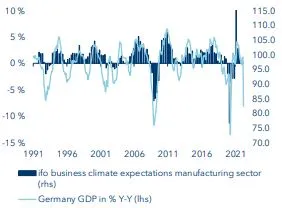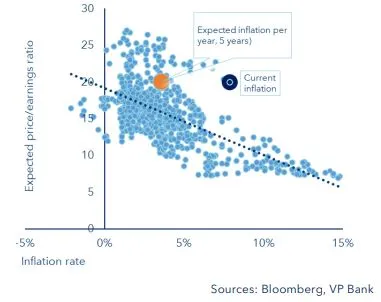Inflation, stagnation – or both at the same time?
Stagflation seems to be the word of the day when it comes to describing the outlook for the near future. In other words, the thinking is that the economy will hardly grow anymore, even as inflation persists. The developments back in the 1970s and early ’80s are drawn on as an example. But the circumstances at the time overlap with the current situation only to a limited extent. Nonetheless, it is worth taking a look at the past in order to gain a better sense of what we are faced with today.
The devil is in the details: Back then, growth rates were all over the map, with the US economy rollercoasting through a boom-bust phase. As a result of the first oil price shock in late 1973, US GDP took a nasty nosedive but was back on course already by the second half of the decade, once again recording annual growth rates in excess of 6%. In the early ’80s the economy collapsed again, and namely twice in rapid succession. But all along the way, the actual stagnation was in the labour market, where the unemployment rate averaged 7.3% between 1974 and 1985.
Economic activity was decisively influenced by the monetary (mis)steps of the US Federal Reserve. Early on, the then Fed chairman Arthur Burns took a laissez-faire approach to the first oil crisis. This meant that his successor, Paul Volcker, had to jam on the monetary brakes ever harder at the end of the decade, a move which coincided with the second oil price shock and ultimately led to the twin recessions in 1980 and 1982. During those volatile years, the German Bundesbank and Swiss National Bank fared much better thanks to the higher priority they gave to fighting inflation in the wake of the first oil price shock.
Recession threats
Today, the fundamental setting is different. The global economy continues to suffer from the consequences of the Corona pandemic, with disrupted supply chains still restraining industrial production. The war in Ukraine has compounded the problem by driving energy costs through the ceiling: oil prices have almost doubled since the beginning of the year, and natural gas in Europe is trading at unprecedented heights. On the all-important Dutch market, gas prices have risen close to sevenfold from the levels where they tended to languish in the last few years.
However, the Fed appears to have learned from the mistakes of the 1970s and is set to tighten monetary policy rapidly. On top of its mid-March 25 basis point rate hike, another seven are expected in the current year. At the same time, the Fed will start trimming its balance sheet in the months ahead, which means a considerable amount of liquidity will be withdrawn from the system as the year progresses. The European Central Bank (ECB) also intends to cease its securities purchases by the end of the third quarter, at which point the likelihood of European rate hikes becomes greater.
It goes without saying that the economic landscape has changed significantly due to the outbreak of war in Ukraine and the resulting surge in energy prices. For Europe, there is now a high risk of recession. The Continent’s key leading indicators have collapsed, and its industry-heavy economy is suffering from oil prices that are at an all-time high in EUR terms. Making things worse, the supply chain problem has become even more acute: Ukraine is an important supplier to the automotive industry, and the Omicron variant of the coronavirus is causing renewed lockdowns in China, which means that manufacturers are also missing crucial components from East Asia. As to the US, the situation looks somewhat better. Vast domestic oil and gas resources make the nation relatively self-sufficient in terms of energy supply, and its very low commercial involvement with Eastern Europe mitigate the economic consequences of the war.
ifo business expectations for the manufacturing sector versus GDP

Consequences of high energy prices
Equally spoken, the risks of recession are also on the rise in the US, but here because of the approach the Fed is taking. Although all the talk today is about stagflation, we prefer to focus primarily on the second part of the word, namely inflation. Inflation rates can be expected to remain high in the short term due to the sharp rise in
energy prices. The spring and summer months should see a certain easing in the headline number thanks to base effects. However, producers and service providers are starting to pass on higher costs to customers and consumers. Going forward, this will add to the breadth and longevity of the price pressures. The Fed's aggressive stance is a clear signal that no inflation rates above its target range around 2% will be tolerated for any extended period in the medium to longer term. Since 1950, ten out of 13 rate-hike cycles have been followed by a recession. An economic contraction dampens aggregate demand and normally leads to lower inflation rates. This time we expect a repeat of that pattern. In Europe as well, the ECB – if faced with a choice between growth or inflation – will almost certainly opt to fight the latter.
It should also be noted that, in terms of the real economy, future inflation rates are highly unlikely to return to the pre-pandemic levels around 1% that we observed for the best part of a decade. The reasons: the mandatory replacement of fossil fuels with renewable energies; the related higher costs; and the move to deglobalize as a way of reducing the dependence on single countries in the supply chains.
The markets are seeking orientation
The goings-on in the economy are mirrored in the financial marketplace. In the short term, investors’ focus will remain on energy and Russia. But they also concerned about the strategically far more significant change process that is under way in international trade relations, which could result in higher costs in the medium to long run.
Phases of rising inflation pose a challenge for investors. The headline figures paint a deceptive picture, especially in times of high inflation. When stagflation sets in, it is difficult to maintain the purchasing power of one’s wealth, as evidenced by data on inflation-adjusted returns. According to the methodology applied by the Asset Manager Schroders, the real annualised return on the US equity market in phases of high inflation and sluggish growth has averaged out at -1.5%. Value stocks outperformed growth stocks, and US Treasuries managed to preserve their real value by at least generating 0.6% p.a., but the latter example is not representative considering today’s low yields. So, preference should be given to top-quality corporate and quasi-government bonds. Inflation-linked securities gain in value when the inflation rate anticipated at the time of purchase actually turns out to be higher during the term to maturity. Real estate investment trust units (REITS), commodities, and in this regard especially gold, have also recorded significant price gains in such phases (see following chart).
Average real (inflation adjusted) yoy return %

Inflation worries with regard to bonds
When coupled with stagnation, inflation poses the greater risk for investors in search of real returns. Today, the Fed is bound and determined to raise interest rates, and this will result in higher yields at the short end of the curve. At the same time, though, the Fed’s firm resolve is taking the upside pressure off of yields on longer maturities. Consequently, it is unlikely that rising yields will cause major price losses in the overall bond segment. However, real returns will remain negative as inflation increases. Meanwhile, the anticipated average inflation rate for the next five years, as derived from inflation-linked bonds, has risen sharply and now stand at 3.7% (USA) and 2.9% (Germany).
For these reasons, we are maintaining our pronounced underweight of government bonds. Insurance-linked securities and microfinance investments are generally rate-insensitive yet benefit from a rise in short-term interest rates. Despite the increased risk of stagflation, investors should not sacrifice diversification. Gold, for example, remains an important portfolio stabiliser.
And keep your powder dry in terms of stocks
Rising inflation also burdens the equity markets, since periods of elevated prices (i.e. more than 4%) at the consumer level are usually consistent with lower P/Es. However, this historical pattern is based on the close correlation between inflation and returns. Higher interest rates reduce the present value of future cash flows, in that the latter need to be more heavily discounted for analytical purposes. Moreover, lofty yield levels make bonds comparatively more attractive than stocks, thereby enticing investors away from the equity market and putting pressure on share prices. Presently, US inflation expectations for the coming years are higher than at any time since measurements began 20 years ago. Although US Treasury yields have risen recently, the move has only taken them back to pre-pandemic levels, and the real return is still in negative territory. In other words, it is currently not very enticing for investors to make the shift from equities to bonds.
Equity market valuations versus inflation in the US

The outlook for the equity markets is essentially binary from today’s perspective. Emotional knee-jerk market reactions in both directions can be expected in the near term. The medium to long-term outlook hinges on the change process under way in international value chains, as well as on the further developments in bond yields. Geographically, the effects will differ: while Europe confronts heightened challenges on the cost side, the US will have to deal with yield developments and their influence on the still lofty fundamental valuations of many shares.
In terms of equities and corporate bonds, the picture for individual business sectors sizes up as follows:
Energy: The surge in natural gas and crude oil prices is generating higher operating cash flows, even as the shift in sourcing creates added revenue potential especially for companies with spare capacity.
Basic materials: Prices for industrial metals, but also minerals, will remain at high levels. Changes in means of delivery and temporary shortages should result in positive special effects, but the offsetting factor in the medium to long run will be the increased risks associated with the environmental pollutants from mining and refining operations.
Automotive: Worldwide, the automotive industry is struggling with supply problems on the part of semiconductor manufacturers. Although the companies have this situation relatively well under control, the shortage of palladium (required for catalytic converters) and the production stoppage of certain components (e.g. wiring harnesses) are now causing additional headwinds. The shares of European carmakers are already trading at historically low fundamental valuations, so downside risks exist above all for US and Asian automotive companies.
Industrial: Heavy industry is suffering above all from today’s higher energy prices, which put a huge strain on production and logistics. However, the companies’ order books are already brim-full due to the Green Transformation. And now, the anticipated increase in defence spending could trigger a boom, especially in the machinery segment.
Banks: Russia’s war of attrition against Ukraine is also taking a toll on companies that have just come away with a whole skin from the pandemic. Today’s added burdens are causing financial stress and thus increase the risk of mounting loan defaults. In addition, bank shares tend to consolidate in phases of a flattening yield curve. It follows that the H1 2022 outlook for banks is neutral to slightly negative.
Healthcare: It is frequently the case that pharmaceutical and healthcare companies enjoy pricing power; hence, they should be in a position to outperform the overall market at least in relative terms. What’s more, many European pharmaceutical companies are attractively valued.
Market phases like the one we are currently witnessing can actually be opportune for medium- to long-term investors, at least from a stock-picking standpoint. Although we have opted to take a cautious approach to asset allocation by underweighting equities for the time being, we recommend that investors with a certain appetite for risk pay special attention to those companies with a solid market position and hefty pricing power. Also, their indebtedness relative to future operating income should be at a manageable level so that interest rate increases do not put a strain on the bottom line.
Companies like these have less of a problem passing on higher input costs and are rather in a position to maintain their profit margins in the face of slower sales growth rates and rising operating costs. Add to this the fact that companies with a dominant market position, unique selling proposition and relatively inelastic demand for their products tend to demonstrate greater stability in an inflationary environment.
Important legal information
This document was produced by VP Bank AG (hereinafter: the Bank) and distributed by the companies of VP Bank Group. This document does not constitute an offer or an invitation to buy or sell financial instruments. The recommendations, assessments and statements it contains represent the personal opinions of the VP Bank AG analyst concerned as at the publication date stated in the document and may be changed at any time without advance notice. This document is based on information derived from sources that are believed to be reliable. Although the utmost care has been taken in producing this document and the assessments it contains, no warranty or guarantee can be given that its contents are entirely accurate and complete. In particular, the information in this document may not include all relevant information regarding the financial instruments referred to herein or their issuers.
Additional important information on the risks associated with the financial instruments described in this document, on the characteristics of VP Bank Group, on the treatment of conflicts of interest in connection with these financial instruments and on the distribution of this document can be found at https://www.vpbank.com/legal_notes_en.pdf



Add the first comment